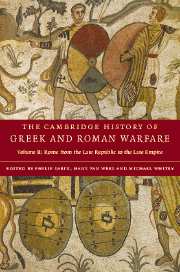Book contents
- Frontmatter
- Part I The Late Republic and the Principate
- 1 International relations
- 2 Military forces
- 3 War
- 4 Battle
- 5 Warfare and the state
- 6 War and Society
- Part II The later Roman Empire
- Chronological table
- Glossary
- List of ancient authors
- Bibliography
- Index of ancient passages cited
- General index
- Map 6. The provinces under Trajan."
- References
2 - Military forces
from Part I - The Late Republic and the Principate
Published online by Cambridge University Press: 28 March 2008
- Frontmatter
- Part I The Late Republic and the Principate
- 1 International relations
- 2 Military forces
- 3 War
- 4 Battle
- 5 Warfare and the state
- 6 War and Society
- Part II The later Roman Empire
- Chronological table
- Glossary
- List of ancient authors
- Bibliography
- Index of ancient passages cited
- General index
- Map 6. The provinces under Trajan."
- References
Summary
The story of the Roman army is one of almost constant evolution and development. Even so, the period of the late Republic and early Principate stands out as one in which Rome’s military forces underwent a transformation in almost every aspect. This transformation reflected the social upheaval and political revolution of the period, but also the massive physical expansion of the empire which brought Rome into conflict with an unprecedented range of enemies, geographically scattered and militarily diverse. It came about little by little, but with major shifts at both the beginning and the end of the first century B.C.
from republic to principate
The decline of the manipular army
At the end of the second century B.C., and even as late as the 80s, it may still be possible to recognize the survival of the citizen manipular army described in the sixth book of Polybius half a century before. However, as described in chapter 11 in vol. I (pp. 356–7), it is clear that groups of three maniples were increasingly being deployed together as a mass to from cohorts. The cohort was essentially a massed grouping of a maniple of hastati, a maniple of principes and a maniple of triarii or pilani, one behind the other as before but no longer separated into three lines, and with ten cohorts forming a legion. The maniple had had its day, and by the 50s B.C. there is little trace of it in the Caesarian corpus, which describes Roman armies tactically almost entirely in terms of cohorts (rather even than of legions).
- Type
- Chapter
- Information
- The Cambridge History of Greek and Roman Warfare , pp. 30 - 75Publisher: Cambridge University PressPrint publication year: 2007
References
- 5
- Cited by

